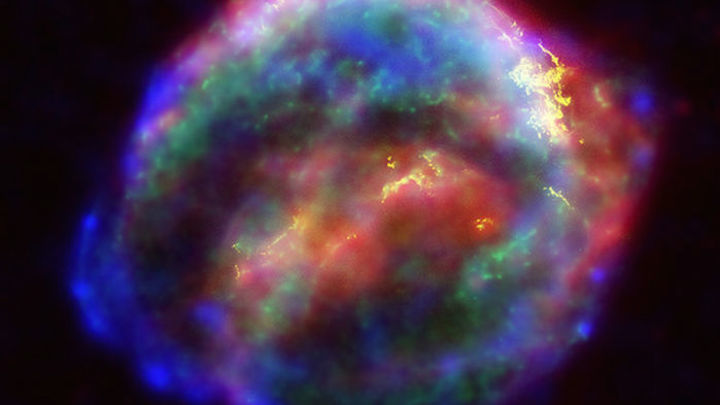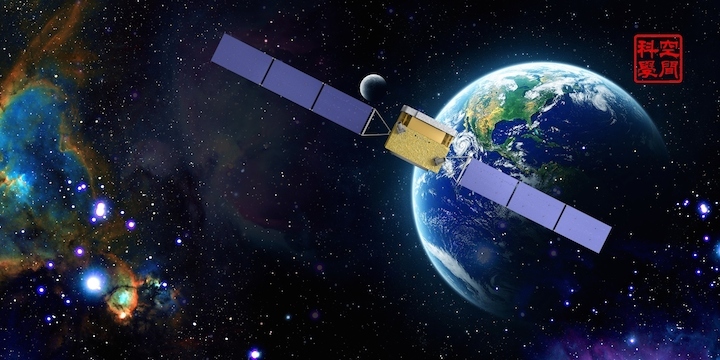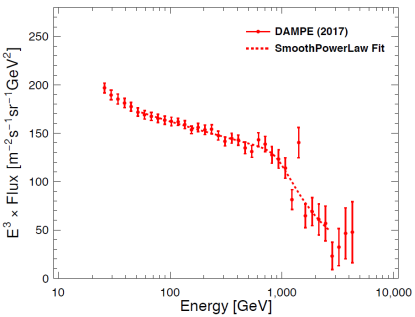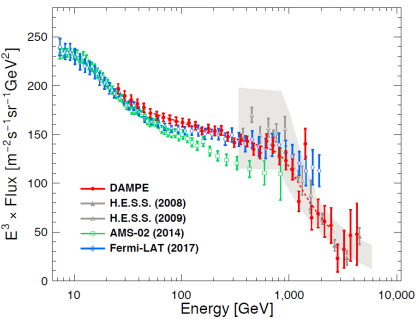30.11.2017
The latest measurement of energy spectrum of cosmic-ray electrons and positrons by China's Dark Matter Particle Explorer (DAMPE) satellite could provide important information to scientists who are searching for the elusive dark matter, according to a study published Wednesday in the journal Nature.
Nicknamed "Wukong" , or Monkey King, the DAMPE satellite was launched into orbit in 2015. The satellite is equipped with instruments that can observe the direction, energy and electric charge of high-energy particles in space.
In this study, the DAMPE Collaboration team reported direct measurements in the energy range 25 gigaelectronvolts to 4.6 teraelectronvolts with extremely high energy resolution and low background.
Nature's Chief Physical Sciences Editor Karl Ziemelis told Xinhua that the spectrum of cosmic rays at high energies provides clues to the origins of these energetic particles, and these origins might include processes involving the still-elusive dark matter.
"These latest measurements, reported in Nature, confirm the impressive potential of the DAMPE satellite for determining this spectrum," said Ziemelis.
The team also find a spectral break, which is an unexpected drop in the number of cosmic-ray electrons and positrons seen at high energies, at about 0.9 teraelectronvolts, confirming previous indirect measurements.
Since 2008, scientists have found "abnormal" phenomena within the one-teraelectronvolt cosmic rays, and some of them believed that such abnormality may be related to dark matter, Yizhong Fan, vice director of the scientific application system of DAMPE, told Xinhua.
If it turns out to be dark matter, its spectrum at high energies may significantly differ from those from regular astronomical processes, therefore measuring the spectral break may help "clarify whether cosmic rays with energy range below one teraelectronvolt come from dark matter", said Fan.
It is believed that only around five percent of the total mass-energy of the known universe is made up of ordinary matter, substances that we know, and the rest is dark matter and dark energy.
Because dark matter does not emit or reflect enough electromagnetic radiation, finding it has proved to be a great challenge to researchers. It is still hard to know whether dark matter is a particle, a field or a misunderstanding of how gravity works.
"The DAMPE satellite is starting to directly measure the properties of cosmic rays at energies that were inaccessible to previous measurements, so we are entering unknown territory -- we do not know what it will find," said Ziemelis. "But whatever it finds will be new and contribute to our understanding of high-energy processes in our galaxy, regardless of whether they involve dark-matter particle annihilation."
Quelle: Xinhua
+++

The remains of Kepler’s supernova, as seen in a composite image produced by NASA. As part of the hunt for dark matter, China’s Dark Matter Particle Explorer mission tracked particles related to cosmic rays produced by supernovae.
China’s dark matter space probe detects tantalizing signal
A long-standing challenge in physics has been finding evidence for dark matter, the stuff presumed to make up a substantial chunk of the mass of the universe. Its existence seems to be responsible for the structure of the universe and the formation and evolution of galaxies. But physicists have yet to observe this mysterious material.
Results reported today by a China-led space science mission provide a tantalizing hint—but not firm evidence—for dark matter. Perhaps more significantly, the first observational data produced by China’s first mission dedicated to astrophysics shows that the country is set to become a force in space science, says David Spergel, an astrophysicist at Princeton University. China is now "making significant contributions to astrophysics and space science," he says.
Physicists have inferred the existence of dark matter from its gravitational effect on visible matter. But it has never been observed.
China’s Dark Matter Particle Explorer (DAMPE) was designed to try to fill that gap, by looking for an indirect decay signal of a hypothetical dark matter candidate called weakly interacting massive particles (WIMPs). Researchers launched the spacecraft from the Jiuquan Satellite Launch Center in the Gobi Desert, about 1600 kilometers west of Beijing, in December 2015. Its primary instrument—a stack of thin, crisscrossed detector strips—is tuned to observe the incoming direction, energy, and electric charge of the particles that make up cosmic rays, particularly electrons and positrons, the antimatter counterparts of electrons. Cosmic rays emanate from conventional astrophysical objects, like exploding supernovae in the galaxy. But if dark matter consists of WIMPs, these would occasionally annihilate each other and create electron-positron pairs, which might be detected as an excess over the expected abundance of particles from conventional objects.
In its first 530 days of scientific observations, DAMPE detected 1.5 million cosmic ray electrons and positrons above a certain energy threshold. When researchers plot of the number of particles against their energy, they’d expect to see a smooth curve. But previous experiments have hinted at an anomalous break in the curve. Now, DAMPE has confirmed that deviation. “It may be evidence of dark matter,” but the break in the curve “may be from some other cosmic ray source,” says astrophysicist Chang Jin, who leads the collaboration at the Chinese Academy of Science’s (CAS’s) Purple Mountain Observatory (PMO) in Nanjing. The DAMPE results appear online today in Nature.
More data will be needed to confirm what DAMPE is possibly seeing. But there is good news on that front. "We expected a 3-year life for the satellite," Chang says. But given the smooth functioning of the spacecraft and its instruments, "we now expect it to last 5 years," he says. That will allow the satellite to record more than 10 billion cosmic ray events. Fan Yizhong, a mission astrophysicist also at PMO, adds that DAMPE's observations will complement those of other space- and ground-based instruments to ultimately clarify whether there is a connection between the anomalous signals and dark matter annihilation.
The DAMPE collaboration comprises four institutes under CAS, including the National Space Science Center in Beijing; also involved are the University of Science and Technology of China in Hefei, the University of Geneva, and Italian universities in Bari, Lecce, and Perugia. The satellite has been named Wukong, after the Monkey King character in the 16th century Chinese novel Journey to the West. DAMPE was also China's first mission dedicated to astronomy and astrophysics, though it was joined in space in June by the Hard X-ray Modulation Telescope, intended to observe x-ray and gamma ray emissions from black holes, neutron stars, active galactic nuclei, and other phenomena.
Even if DAMPE's data don't resolve the dark matter riddle, Spergel says, "These measurements will inform our understanding of cosmic ray acceleration [and] will tell us about the physical processes in shocks around supernova and the physics of pulsars."
Quelle: Science
+++
First Finding of China's DAMPE May Shed Light on Dark Matter Research

Concept figure of the DAMPE satellite (Image by NSSC)
The DArk Matter Particle Explorer (DAMPE, also known as Wukong) mission published its first scientific results on Nov. 30 in Nature, presenting the precise measurement of cosmic ray electron flux, especially a spectral break at ~0.9 TeV. The data may shed light on the annihilation or decay of particle dark matter.
DAMPE is a collaboration of more than a hundred scientists, technicians and students at nine institutes in China, Switzerland and Italy, under the leadership of the Purple Mountain Observatory (PMO) of the Chinese Academy of Sciences (CAS). The DAMPE mission is funded by the strategic priority science and technology projects in space science of CAS.
DAMPE, China’s first astronomical satellite, was launched from China’s Jiuquan Satellite Launch Center into sun-synchronous orbit on Dec. 17th, 2015. At an altitude of about 500 km, DAMPE has been collecting data since a week after its launch.
In its first 530 days of science operation through June 8 of this year, DAMPE has detected 1.5 million cosmic ray electrons and positrons above 25 GeV. The electron and positron data are characterized by unprecedentedly high energy resolution and low particle background contamination.

Fig. 1. The electron plus positron spectrum measured by DAMPE. (Image by the DAMPE collaboration)
Figure 1 shows the first published results in the energy range from 25 GeV to 4.6 TeV. The spectral data in the energy range of 55 GeV-2.63 TeV strongly prefer a smoothly broken power-law model to a single power-law model.
DAMPE has directly detected a spectral break at ~0.9 TeV, with the spectral index changing from ~3.1 to ~3.9. The precise measurement of the cosmic ray electron and positron spectrum, in particular the flux declination at TeV energies, considerably narrows the parameter space of models such as nearby pulsars, supernova remnants, and/or candidates for particle dark matter that were proposed to account for the “positron anomaly” revealed previously by PAMELA and AMS-02, according to FAN Yizhong, deputy chief designer of DAMPE’s scientific application system.
“Together with data from the cosmic microwave background experiments, high energy gamma-ray measurements, and other astronomical telescopes, the DAMPE data may help to ultimately clarify the connection between the positron anomaly and the annihilation or decay of particle dark matter,” said FAN.
Data also hint at the presence of spectral structure between 1 and 2 TeV energies – a possible result of nearby cosmic ray sources or exotic physical processes. Yet, more data are definitely required to explore this phenomenon.
DAMPE has recorded over 3.5 billion cosmic ray events, with maximum event energies exceeding ~100 trillion electronvolts (TeV). DAMPE is expected to record more than 10 billion cosmic ray events over its useful life – projected to exceed five years given the current state of its instruments.
More statistics will allow more precise measurement of the cosmic ray electron and positron spectrum up to ~10 TeV. Scientists will also be able to explore spectral features potentially generated by dark matter particle annihilation/decay or nearby astrophysical sources, e.g., pulsars.

Fig. 2. A comparison of electron plus positron spectrum measured by DAMPE with other published measurements. (Image by the DAMPE collaboration, from the Nature paper)
Figure 2 compares the results of the cosmic ray electron and positron spectra from DAMPE and other experiments. The DAMPE results reported here demonstrate the unique capability of DAMPE to explore possible new physics and/or new astrophysics in the TeV energy window, thanks to its high energy resolution, large instrumental acceptance, wide energy coverage, excellent electron/proton separation power, and long working life.
DAMPE’s first scientific result is a milestone for the international collaboration. The mission will continue to study galactic cosmic rays up to ~10 TeV for electrons/gamma-rays and hundreds of TeV for nuclei, respectively. DAMPE data is expected to reveal new phenomena of the universe in the TeV window.
Additional Background
PMO, under the leadership of Principal Investigator CHANG Jin, proposed and led the initial design of DAMPE. The Plastic Scintillator Detector (PSD) was constructed by the Institute of Modern Physics, CAS. The Silicon-Tungsten tracKer-converter (STK) detector was jointly developed by the Institute of High Energy Physics, CAS, the University of Geneva (UniGE), and INFN Perugia. The BGO imaging calorimeter was jointly developed by the University of Science and Technology of China (USTC) and PMO. The Neutron Detector was constructed by PMO. The Data Acquisition System was made by National Space Science Center, CAS. The data analysis work of the DAMPE international Collaboration is the result of the scientists in all the participating institutes (PMO, USTC, IHEP, IMP, UniGE, INFN and University of Perugia, Bari, Lecce, NSSC). The scientific activities are coordinated by the ground Scientific Application System led by PMO, USTC, and UniGE, in a competitive but still collaborative effort finalized to the release of highest level scientific results.
Quelle: Chinese Academy of Sciences
